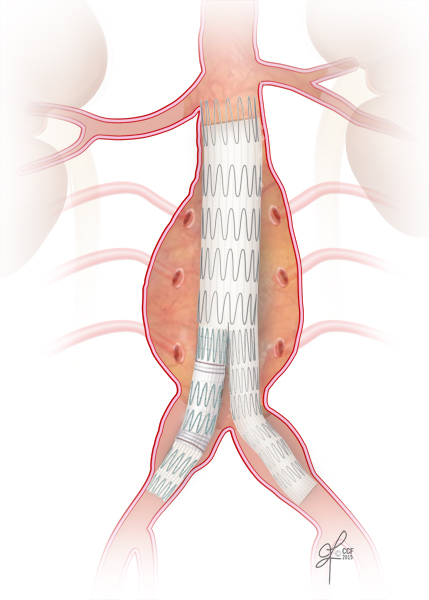How To Repair A Leakinh Stent
Overview

What is an Endoleak?
During endovascular aneurysm repair (EVAR), a textile-covered stent (stent graft) is put in place to reinforce the areas of the aorta that are weak due to an aneurysm. The stent provides a new path for blood flow, which keeps blood from reaching the aneurysm.
An endoleak is a complication that affects most 15-25% of patients who take EVAR. It means that some corporeality of claret flow still remains in the aneurysm crenel.
How is an Endoleak Diagnosed?
Imaging studies, such as CT scans, ultrasounds and MRIs, are done during and afterward an EVAR procedure. These tests testify if the process was successful and if the stent graft is in identify and working. They also prove any leaks around the stent. An angiogram is washed at the end of the procedure which usually allows the proceduralist to run into Type I, 3 and sometimes Type II endoleaks. Mail operative imaging modalities like CT and US should exist performed for the life of the endograft as it is possible for endoleaks to develop in a delayed manner. Your doctor will let yous know how often you need to come in for imaging tests.
Types of Endoleaks
There are several types of endoleaks, classified as types I to Five. Types I and II are the virtually mutual.
Endoleak - none present
Endoleak - Blazon I
Type I endoleak: A Type I endoleak is a leak that occurs effectually the elevation or bottom of the stent graft. Considering blood flowing from the top or bottom areas of the stent graft has high flow, Type I leaks are typically treated with a greater sense of urgency one time they are identified.
Endoleak - Type II
Type Two endoleak: Type 2 endoleaks are the most common. These are leaks that happen when blood flows into the aneurysm sac from branches of the aorta, or other claret vessel treated with a stent. The claret flows into the aneurysm sac cavity through modest branches which enter the treated aneurysm.
Endoleak - Type Three with leak from overlapping segments
Type Iii endoleak: Occurs when in that location is separation of overlapping stent graft components which allows pressurized blood menstruation to enter the aneurysm cavity.
Endoleak - Type III due to tear in graft
Type III endoleak: Occurs when there is separation of overlapping stent graft components which allows pressurized claret menstruum to enter the aneurysm crenel.

Endoleak - Type IV due to blood passing through the fabric of the graft into the sac
Type IV endoleak: Occurs when there is blood flow through the pores of the stent graft. This blazon of endoleak is infrequently seen with our newer generation stent graft devices.
Endoleak Unknown Cause
Process Details
What Happens if I Have an Endoleak?
If you accept an endoleak, yous will demand treatment. The outset step is for your physician to determine the type of endoleak. The type of handling y'all need depends on the type of endoleak you have and the size of the aneurysm sac. It is of import to see an experienced endovascular aorta surgeon for treatment.
Treatment for Blazon I Endoleak
If you have a Type I endoleak, treatment should exist done correct abroad. This may include:
- Special balloon stents
- Extending the stented area of the aorta by placing stents beyond the leaking end of the graft
- Placing special cuffs at the end of the graft
- Apply of special glue-like materials to close off the graft
- If the graft cannot exist repaired using an endovascular technique, you may demand an open repair/surgery to remove the stent graft and repair the aneurysm in standard open up mode. (Cleveland Clinic has one of the largest worldwide experiences in the removal of aortic stent grafts-known every bit EVAR explant)

Treatment for Blazon II Endoleak
Type II endoleaks sometimes stop without treatment. This happens if the branches of the blood vessels that are leaking clot off and end sending blood to the aneurysm. If this is the case, you will need imaging tests on a regular basis to scout for changes.If the leak does non end and causes the aneurysm to get bigger, treatment to close-off the claret vessels may include:
- Utilise of a special glue-like material to cease the bleeding
- Laparoscopic techniques to tie off the blood vessels
- If the graft cannot be repaired with endovascular technique, you may need open up surgery to tie off the blood vessels and repair the graft
Investigational Treatments for Patients With Endoleaks
Studies are existence done to test a new aortic stent graft device which may reduce the charge per unit of Blazon II endoleaks. This investigational device involves a stent which is covered on the outside with a special endobags. One time the stent is expanded to treat the aneurysm the endobag is filled with a substance that fills the aneurysm cavity and hardens. The hardened endobag prevents blood from flowing into the aneurysm cavity from side branches. Thus reducing the rate of Type II endoleaks. The endobags also reliably set the stent graft in place and therefore may reduce the rate of stent graft migration. Stent graft migration is 1 of the common causes of delayed Blazon I endoleak. Cleveland Clinic is part of a a multi-center study to see if these devices are safe and constructive.
How To Repair A Leakinh Stent,
Source: https://my.clevelandclinic.org/health/treatments/16960-endoleak-treatments
Posted by: gillettemorselp.blogspot.com


0 Response to "How To Repair A Leakinh Stent"
Post a Comment